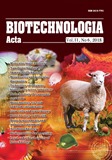ISSN 2410-776X (Online)
ISSN 2410-7751 (Print)

Biotechnologia Acta, Т. 11, № 6, 2018
https://doi.org/10.15407/biotech11.06.039
Р. 39-46, Bibliography 19, English
Universal Decimal Classification: 573.6.086.8/35:585.274.2
A. V. Kotinskyi1, A. I. Salyuk1, S. A. Zhadan2
1National University of Food Technologies, Kyiv, Ukraine
2Individual entrepreneur «Dyba А. О.», Kyiv, Ukraine
The aim of the work was to study the impact of glycine on Spirulina growth and photosynthetic processes intensity. For research the culture of Spirulina platensis (Gom.) Geitl cyanobacterium strain LGU — 603 from collection of Kholodny Institute of Botany of the National Academy of Sciences of Ukraine was used. The cultivation process was carried out in Zaruk nutrient medium in a vertical tubular apparatus of 8 cm in diameter and of volume 2 dm3 in a constant mixing of the culture medium with air.
Introduction of glycine in a cultural environment resulted in the increase of the Spirulina productivity, maintenance of basic photosynthetic pigments and protein. Glycine introduction allowed to increase the growth rate of spirulina and to content achieve the high density of the culture due to the increased length of log-phase. Intensification of Spirulina platensis growth and its productivity increase was due to the fragmentation of cyanobacteria trichomes, so the increase of trichomes number with a small number of cells, which grow quickly. The degree of fragmentation depended on the concentration of introduced glycine and on the culture development stadium and also on introduced glycine concentration.
Key words: glycine, spirulina, growth and photosynthetic processes intensity, photosynthetic activity.
© Palladin Institute of Biochemistry of National Academy of Sciences of Ukraine, 2018
References
1. Henrikson R. Earth Food Spirulina. Renore Enterprises, Inc. Laguna Beach, California. 1989, P. 25–95.
2. Campanella L., Crescentini G., Avino P. Chemical composition and nutritional evaluation of some natural and commercial food products based on Spirulina. Analusis. 1999, 27 (6), 533–540. https://doi.org/10.1051/analusis:1999130
3. Ciferri О. Spirulina, the edible Microorganism. Microbiol. Rev. 1983, 47 (4), 551–578.
4. Belay A. The potential application of Spirulina (Arthrospira) as a nutritional and therapeutic supplement in health management. J. Amer. Nutr. Assoc. 2002, 5 (2), 27–48.
5. Duncan P. L., Klesius P. H. Effects of Feeding Spirulina on Specific and Nonspecific Immune Responses of Channel Catfish. J. Aquatic Anim. Health. 1996, N 8, P. 308–313. https://doi.org/10.1577/1548-8667(1996)008<0308:EOFSOS>2.3.CO;2
6. Seshadri C. V. Large Scale Nutritional Supplementation with spirulina alga. All India Project. Shri Amm Murugappa Chettiar Research Centre (MCRC) Madras. 1993, 79 р.
7. Drobetskaya I. V. The use of urea in the cultivation of blue-green microalga Spirulina platensis (nordst.) geitl. in a cumulative culture. Ekologiya morya. 2002, V. 60, P. 53–59. (In Russian).
8. Rudik V. F., Bulmaga V. P., Kirnyak T. V., Chapurina L. F. Productivity and biochemical composition of Spirulina platensis (nordst.) geitl, Calu-835 when cultured in the presence of coordination compounds Zn (II). Algologiya. 2003, 13 (3), 322–330. (In Russian).
9. Skorokhod T. F., Tupik N. D., Chernya V. F. Dependence of the lipid composition of Spirulina platensis (Nordst.) Geitl. from the mode of energy existence of culture. From photoautotrophy to photoheterotrophy. Algologiya. 1996, 6 (2), 133–141.
10. Marquez Facundo J., Nishio Naomichi, Nagai Shiro. Enhancement of biomass and pigment production during growth of Spirulina platensis in mixotriphic culture. J. Chem. Technol. Biotechnol. 1995, 62 (2), 159–164. https://doi.org/10.1002/jctb.280620208
11. Drobetska I. V. Effect of mineral nutrition on growth and chemical composition Spirulina platensis (Nordst.) Geitler. M.S. thesis … candidate of biological sciences. Instytut biolohii pivdennykh moriv im. O. O. Kovalevskoho, Sevastopol, Ukraine. 2005. (In Ukrainian).
12. Rudik V. F., Gudumak V. S. The method for determining the absolutely dry biomass of halophilic microalgae. USSR Author’s Certificate № 1402940. June 15, 1988. (In Russian).
13. Palladin A. V., Kirsenko O. V. Adenosine triphosphatase in various cell fractions of the brain. Biokhimiya. 1961, 26 (2), 385–390. (In Russian).
14. Boussiba S., Richmond A. Isolation and characterization of phycocyanins from blue-green alga Spirulina platensis. Arch. Microbiol. 1979, V. 120, P. 155–159. https://doi.org/10.1007/BF00409102
15. Peterson N. V., Chernomyrdina T. O., Purelyan E. K. Workshop on plant physiology. Kyiv: Ukrainska silskohospodarska akademiia. 1993, 137 p. (In Ukrainian).
16. Kotynskyi A. V., Salyuk A. I., Batishcheva H. S. Particular qualities the effect of glycine on the growth of the microalgae spirulina platensis (Gom.) Geitl. Naukovi pratsi NUKHT. 2014, 20 (1), 38–45. (In Ukrainian).
17. Kotinskyi A., Saliuk A. The effect of glycine on the growth of the miscroalgae spirulina platensis. Second North and East European Food Science Congress (NEEFood-2013): Collection of abstracts (in English). Kyiv: NUKHT. 2013, P. 179. (In English).
18. Lehninger А. Fundamentals of Biochemistry. Moskva: Mir. 1985, V. 2, P. 662–664. (In Russian).
19. Averina N. G., Yaronskaya E. B. Biosynthesis of tetrapyrroles in plants. Minsk: Belarus. navuka. 2012, 413 p. (In Russian).

